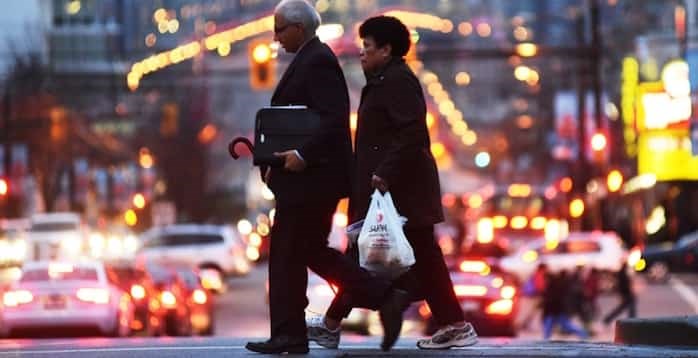 While pedestrians are involved in less than one per cent of the overall traffic collisions, they account for more than 60 per cent of all traffic fatalities in Vancouver. Photo Dan Toulgoet
While pedestrians are involved in less than one per cent of the overall traffic collisions, they account for more than 60 per cent of all traffic fatalities in Vancouver. Photo Dan Toulgoet
With daylight savings time set to come to an end this weekend, and the darker, wetter weather upon us, the City of Vancouver, ICBC and Â鶹´«Ă˝Ół»police are reminding the public to practise road safety whether driving, walking or riding.
“The City of Â鶹´«Ă˝Ół»has a goal to eliminate traffic-related fatalities and serious injuries from happening on our streets,” Jerry Dobrovolny, general manager of engineering services, said in a press release. “Even when we build for safety, we need to work together as a community to raise awareness about the rules of the road and how we can all make sure we are travelling safely.
“We depend on everyone to take accountability for their daily behaviour, and rely on our partners from ICBC and VPD to help educate and enforce good behaviour.”
Particularly, people walking are the most vulnerable and among those walking, seniors are the most likely to suffer a serious injury, or fatality, as a result of a crash with a vehicle or bicycle.
“Nearly half of all crashes with pedestrians happen between October and January, as visibility and conditions worsen,” said Aileen Shibata, ICBC road safety program coordinator. “Whether you’re driving or walking, the most important thing you can do is focus on the road. It’s up to each of us to do our part to help keep pedestrians safe.”
Collisions between people walking or wheeling are more frequent between 3 p.m. and 8 p.m. and during hours of darkness in winter months. And while pedestrians are involved in less than one per cent of the overall traffic collisions, they account for more than 60 per cent of all traffic fatalities in Vancouver.
“Road safety is a shared responsibility,” said VPD Const. Anne-Marie Clark. “Through ongoing education and enforcement, we will continue to work with our partners to make our roadways safe for all pedestrians, cyclists and motorists.”
Road Safety Tips
When driving:Â Slow down at intersections and wait until pedestrians have crossed the road. If possible, make eye contact with people walking. Do not pass cyclists unless you have at least 1.5 metres of space.
When cycling:Â Take it slow (especially at intersections and roundabouts). Make eye contact with other road users, if possible, and yield to pedestrians. Use front and rear bike lights, and take designated bike routes where possible.
When walking: When crossing the street, make eye contact with drivers and cyclists if possible. Wear bright or reflective clothing to be more visible in the dark. Don’t jaywalk — use crosswalks and follow pedestrian signs and traffic signals.


